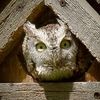"Talk and Turn" wildlife approach method.
Apr 10, 2013 17:13:29 #
Nikonian72 wrote:
I got tired just reading this!
Well I am sure Mt Shooter has a few pastries hidden somewhere and sips coffee from a backpack mount he has designed himself...
However, the wife sneaks up on me the same way when I am looking at camera reviews...and she has the constantly talking part down to a science
Apr 10, 2013 19:56:26 #
Apr 10, 2013 20:55:12 #
Brian in Whitby
Loc: Whitby, Ontario, Canada
Thank you for formalizing a method I have been using for years. Being able to read the animal's body language is also helpful but that comes mostly with experience. If you can tell when an animal is nervous and when it it relaxed, you have a better chance of a successful non-stalk.
That said, I have also used stalking successfully. There are too many variables to describe when each method is likely to be successful.
That said, I have also used stalking successfully. There are too many variables to describe when each method is likely to be successful.
Apr 10, 2013 21:31:07 #
You know thats the way I snuck up on my wife. I didn't want to scare her off. I guess it worked we have been togather now for going on 63 years. But all kidding aside MT thanks for taking the time to explain your method of aproaching wild life. Looking at your photos proves it works.
Apr 10, 2013 21:43:28 #
Apr 10, 2013 23:51:22 #
MT Shooter, that is some very good advice. As a bird photographer, I have used a similar method to get close to a variety of species. It does not work on all species. Some just move around so much that you just don't have enough time. It seems to help if the birds are engaged in some other activity like feeding or nest building. Some birds have periods of loafing, raptors, egrets, herons, vultures etc. These are good time to approach.
One thing I have noticed is that juveniles tend to be more approachable than adult birds, especially raptors. Just like human teenagers, they appear more curious.
As to not looking at them periodically, my experience is that many birds use that as the moment to escape. I can't tell you how many times I have looked down to see where I am placing my foot only to look back up and see that the bird has disappeared!
One thing I have noticed is that juveniles tend to be more approachable than adult birds, especially raptors. Just like human teenagers, they appear more curious.
As to not looking at them periodically, my experience is that many birds use that as the moment to escape. I can't tell you how many times I have looked down to see where I am placing my foot only to look back up and see that the bird has disappeared!
Apr 11, 2013 01:15:08 #
Thanks for that detailed explanation, after seeing those incredible photos of the red tailed hawk, I will definitely have to give it a try.
Guess I will have to leave the wife and dog at home :)
Guess I will have to leave the wife and dog at home :)
Apr 11, 2013 01:16:40 #
kubzilla wrote:
Thanks for that detailed explanation, after seeing those incredible photos of the red tailed hawk, I will definitely have to give it a try.
Guess I will have to leave the wife and dog at home :)
Guess I will have to leave the wife and dog at home :)
You could leave the dog in the car.
Apr 12, 2013 13:55:51 #
MT Shooter wrote:
I have been asked several times to detail my Talk-... (show quote)
MT, great explanation. Love it. One of the reasons this works so well is no preditor(even us) will not retreat. So retreating will allow you to get closer.
Apr 22, 2013 17:36:51 #
That is an outstanding approach method. I used a similar method in approaching a gathering of wild bighorn sheep in the San Gabriel Mountains in Southern California. Got close enough to get just head and shoulder photos with a 600mm lens.
Apr 22, 2013 17:55:08 #
MT...Just for clarification....please list the species that this method DOES NOT work with.
Apr 22, 2013 18:10:15 #
SteveR wrote:
MT...Just for clarification....please list the species that this method DOES NOT work with.
I guess that list would have to include attractive women! ;-)
Apr 22, 2013 20:54:55 #
MT Shooter wrote:
I guess that list would have to include attractive women! ;-)
The part about the high pitched voice will definitely not work with this species.
Apr 23, 2013 11:33:28 #
I tried this out the other day on a Muskrat in my backyard. I hummed because I couldn't think of anything to say to myself... I got about 10 feet from it and got a good shot. He was pretty relaxed which was awesome since my dog had him pretty riled only 20 minutes earlier. I think the scary part was not looking at him and not being able to see him out of the corner of my eyes when I turned away. Thanks MT Shooter. That's going to be fun to practice!
Apr 23, 2013 13:36:31 #
The only problem with this technique is that my neighbors think I am nuts. One of them won't even speak to me anymore! But if it gets me a good shot, who needs neighbors :)
If you want to reply, then register here. Registration is free and your account is created instantly, so you can post right away.









